Project TH – Municipal Waste Incineration Bag Filter with Sodium Bicarbonate and Activated Carbon Injection
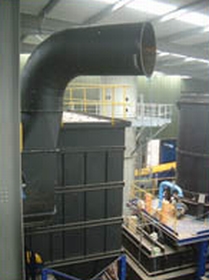
Summary
From initial enquiry to completion of installation this project extended over 20 months.
The requirement was for a gas cleaning plant and sorbent injection systems to remove toxic waste gases from a new commercial waste incineration plant.
The plant was housed in a new building and comprised a dual feed system of mixed biomass waste handling equipment, conveying systems, incinerator, boiler, bag filter, sorbent silo, gas re-circulation, chimney with CEMS equipment, SCADA system, turbine, auxiliary cooling and associated platforms and walkways.
Supply Highlights
- Biomass Waste Handling Filter
- Dual line Bag Filter System
- Pulse Jet Filter Design with Gas Distribution Screen
- Design, supply, installation, commissioning
- High Temperature Filter Bags
- Special filter cages with Anti-corrosive Coating
- Dual line Sodium Bicarbonate Injection System with 60 cubic metre silo on load cells
- Dual line Activated carbon injection system
- Filter insulation lagging and cladding
- Trace Heating to avoid acid condensation at dew point
- High temperature equipment
- FIBC discharge from 7m screw conveyor
- Installation within limited space
- Automated HCl control
Supply Detail
Filter Details:
- Bag diameter 127 mm
- Bag length 3.5 m
- Filter arrangement 48 rows of 14 bags
- Area per bag 1.4 m²
- Total bags 672
- Filtration Area 940 m²
- Filtration Velocity 1.24 m/min
- Filtration Media PTFE on Glass
- Design filter resistance 760 mm water gauge
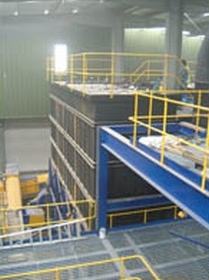
A customised design dual line CleanPulse filter system consists of 2 entirely separate filters which are side by side and separated by a walkway platform.
Waste gases enter the filter and are directed into the filter inlet distribution duct with distribution screen.
The screen consists of gas distribution plates to evenly distribute the gas along the length of the filter, followed by a second system to direct flow towards the top of the filter bags actively encouraging down flow of the gases.
This system effectively removes the larger particles, protects the bags and reduces the pulsing requirements.
The CleanPulse bag filter deals with 68,394 actual cubic metres per hour of waste gas.
It filters the gases at approximately 200 degrees centigrade after they have travelled through the thermal oxidiser and boiler.
The boiler reclaims some heat for use elsewhere on site and passes the waste gas now containing fine particulate and HCl, among other constituents.
The fine particulate is trapped by the 672 filter bags inside each filter which together total 1881 square metres of PTFE on glass filter media filtering the gas at a rate of 1.24 metres per minute.
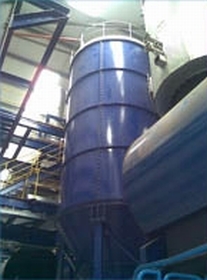
A dual line sorbent injection system involves a single large 60 cubic metre storage silo containing sodium bicarbonate.
Sodium Bicarbonate is fed into the waste gas stream via a dual feed system.
The sorbent acts as an agent to remove the HCl from the waste gas stream.
On the top of the filter is a second small venting filter which vents the air exiting the silo during tanker filling.
The fill pipe for the silo is outside alongside the main entrance for convenience of filling.
A comprehensive silo safety system is installed to prevent overfilling and includes alarms and fail safe controls.
In the event of overfilling, the blow line to the silo shuts to prevent further filling.
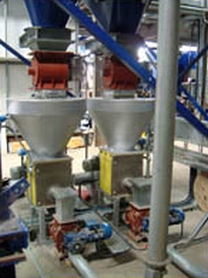
The sorbent powder (sodium bicarbonate) is discharged from the silo via a rotary valve, surge hopper, feeder and blowing seal arrangement.
This has the capability of being controlled on the basis of HCl levels by CEMs monitoring equipment should the end user choose to upgrade the plant in the future.
The entire silo is mounted on load cells to monitor the exact sorbent level which allows the consumption to be accurately logged.
The sorbent is conveyed via a blow line assisted by a blowing fan into the inlet ducts just prior to the filter inlet.
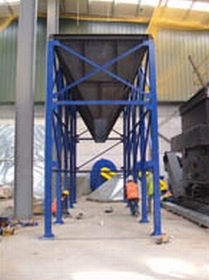
The filter is erected on a support structure installed first.
This support is isolated from the heat generated in the filter by using special composite pads between filter and support.
This prevents the support structure from getting hot and also prevents heat loss or cold spots in the filter system.
The support is erected with reference to a site datum which is critical to allow the top sections of the filter and intermediate platform to align correctly.
In addition, the associated ducting and expansion joints have been designed based on specific dimensions.
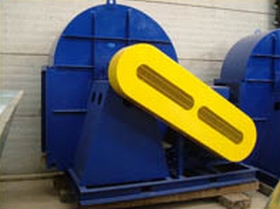
The fans are inverter controlled to allow continual control of flow rates depending on the status of other components in the plant.
The fans pull the waste gas through the entire system and are critical to correct operation of the waste incineration plant.
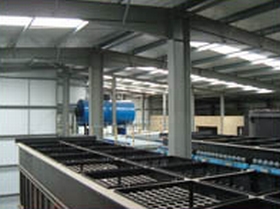
This image shows a view over both filters before the top access doors are fitted.
The height required to remove the 3.5m long bags was just adequate for easy bag changes.
However, with the incineration waste gases being directed through the filter diffusion screen, the bags should last several years even during 24 hour, 7 day, 365 days a year operation.
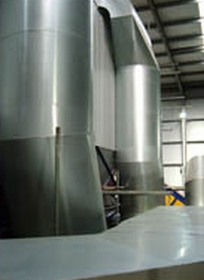
The filter outlet ducting is lagged with insulation to ensure safety of personnel on site and to prevent heat losses within the filter.
This prevents any cold spots which could lead to acid corrosion in the filter.
At this point in the erection, the filter and ducting systems start to look finished.
This waste to energy plant has been running for 12 months and the dust emissions read zero!
The sodium bicarbonate usage is between 40 and 120kg/hr depending on the composition of the waste gas stream.
When more plastics are incinerated, the HCl level rises, requiring more sodium bicarbonate injection to offset this.
The activated carbon usage is stable at around 3kg/hour which offsets the dioxins in the waste gas stream.
A urea injection system is also part of the waste gas treatment plant and offsets NOx, but was supplied by others.
Our recent Projects
We were contracted to provide 2 small Ceramic filters suitable for a small volume but with a design maximum temperature of 600°C. In addition the filters will be handling a syngas which cannot be mixed with oxygen so an alternative to compressed air would need to be used for the ‘Cleanpulse’ cleaning of the 25 Ceramic element in each of these CPC78 filters. In addition dosing of small amounts of a re-agent is required so the client also opted for a ‘Cleandose’ 25kg bag skid. Find out more about Project CAD below.


